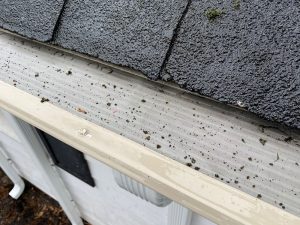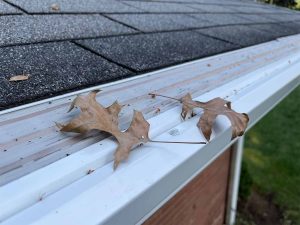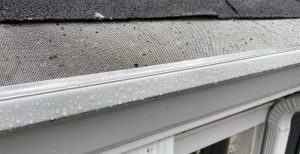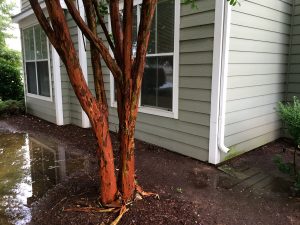Brian wrote to us that when he recently cleaned his gutters, he found a lot of shingle sediment build-up in his gutters. Brian asked, “What exactly is sediment and does it contribute to clogging gutters?”
Brian, thanks for your question.
Shingle sediment is made up primarily of sand-like granules or grit that separate from asphalt shingles, and other small matter that sticks to the roof surface and washes into gutters. Granules naturally separate from shingles over its life. It seems to be most prevalent early and later in the shingles life. In other words, when shingles are new, excess granules from the manufacturing process fall off when somebody walks on roof and when it rains. Later in life, as the shingles become more brittle, granules continue to fall off, exposing the shingles fiber underlayment.
While homeowners, roofing contractors, and gutter guard dealers may pass-off the idea that shingle granules in gutters can be an issue, I have a different perspective on this topic. Most homes on which we install gutter guards have moderate to significant accumulation of shingles granules in the gutters. It doesn’t matter whether or not we’re replacing existing gutter guards — shingle granules get into the gutters! We have seen granule accumulations as deep as 2-3″, which accounts for roughly 50% of the area within a gutter.
Here’s an anology: equate shingle granules to sand dunes along your favorite beach. Sand dunes are there to serve as a buffer between the water and the mainland. Sand dunes slow the advancement of water, it is a place for grasses and vegetation to grow, and it creates a natural barrier that makes it difficult for small things to climb or blow over the top of dunes.
Now imagine a bunch of small sand dunes inside your gutter. This sediment is going to act the same way as sand dunes on your favorite beach. This means that they’ll slow the advancement of water from the high end of the gutter to the downspout, leaves and small debris will get stuck behind the granule build-up, and it becomes a natural, fertile breeding ground for plant life. Yes, when you see small plants and trees sprouting out of your gutters in the spring and summer, the seeds have lodged in the granules and sediment (soil) before they sprout to become prospering plant life. Now if it were just that easy to grow plants at ground level!
Earlier this summer, we compared micro mesh/screen gutter guards and traditional reverse curve systems to see how they handle the accumulation of shingle granules. The bottom line is that the micro mesh/screen gutter guards did an excellent job of keeping shingle granules out of the gutters because the micro-screens were smaller than the smallest granules and debris that washes off the roof surface.
Reverse curve systems, on the other hand, have large enough openings that granules and small debris will enter the gutters. If you refer back to the blog posts, you’ll see which of the micro screen gutter guards performed the best.







